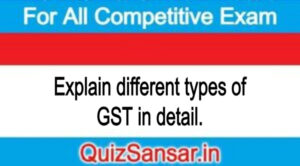
Explain different types of GST in detail.
Explain different types of GST in detail.
or
Explain CGST and SGST in detail.
Ans.
Types of G.S.T.
India has implemented dual GST. In dual GST regime, all the intra-State transactions of goods and services made for a consideration would attract two levies i.e., CGST (Central GST) and SGST (State GST) or UTGST. While inter-State supplies would attract IGST.
Central Goods and Services Tax (CGST)
The Central GST (CGST) has replaced the earlier Central Excise Duty and service tax. CGST also cover sale transactions. The Constitution (101st Amendment) Act, 2016 contains suitable provisions to enable Centre to tax sales. CGST would be administered by the Central Government under the Central Goods and Services Act, 2017 and rules made thereunder. The CENVAT credit balance available under CENVAT Credit Rules with the manufacturer or service provider, as on the 1st July, 2017, could be carried forward. In respect of tax paid goods in stock as on 1st July, 2017 credit not availed in the past or not eligible at that point of time, available under GST could also be availed and used towards disbursing CGST (Central GST) liability. There could be a time bound transition for carry forward of credit availed prior to introduction of GST.
Features of CGST
Salient features of CGST are as follows:
1. CGST has been implemented after subsuming Central indirect taxes such as Excise Duty, Service Tax and other additional taxes.
2. Administration and utilisation of all the amount collected under CGST shall lie with Central Government.
3. Amount of CGST charged shall be shown separately in the Tax Invoice and shall be deposited into account of the Central Government as per rules.
4. Half of the GST chargeable is CSGT component. For example, if GST rate is 12%, the rate of CGST shall be 6%.
5. For administration, the CGST Act, 2017 and CGST Rules, 2017 have been notified having whole of the India, jurisdiction.
Example- Assuming 28% GST on A. C. and Fridge manufacturer will issue Tax Invoice after charging 14% CGST and 14% SGST, for which input tax credit shall be available to the dealers under distribution chain till the product reaches to the final consumer.
State goods and services tax (SGST)
State GST would replace State VAT, Entry tax, Octroi, Luxury tax, Entertainment tax, etc. SGST would be levied on services as well. To enable taxing of services by the State, the Constitution (101st Amendment) Act, 2016 contains suitable provisions. SGST is to be administered by the State Governments under concerned State Goods and Services Act, 2017. The SGST payable could be set-off from the SGST credit or the IGST credit available. The closing input VAT balance available under the VAT Act would also be made available to the dealer, as on 1st, July, 2017 into GST and could be set-off towards SGST liability. Further, the duty and tax paid on the closing stock also available as credit, which have not been claimed as set-off in the VAT regime.
Features of SGST
Salient features of SGST are as follows:
1. SGST has been implemented after subsuming State VAT, Entry Tax and other taxes and cesses till now chargeable by the State Governments.
2. Before SGST, States were charging various taxes and cesses arbitrarily at different rates. Now all 29 States charge SGST at an uniform rate as prescribed.
3. Half of the GST charged, is the component of SGST. If chargeable GST is 18%, 12% and 5%, SGST component shall be 9%, 6% and 2.5% respectively.
4. Charged SGST shall be shown separately by the supplier under Tax-invoice.
5. Amount collected under SGST shall be utilised by the State where supplier and recipient both are located.
6. Every State has enacted its own SGST Act, based upon Model GST laws.
Example- A trader of Jaipur supply goods valued 2 lakh to a trader of Bikaner Charging 6% CGST and 6% SGST under Tax-invoice. The amount charged against SGST shall be deposited to the account of Rajasthan Government.
Utgst (Or UGST)
UTGST full form is Union Territory Goods and Services Tax
The Union Territory Goods and Services Tax, commonly referred to as UTGST, is the GST applicable on the goods and services supply that takes place in any of the five Union Territories of India, including Andaman and Nicobar Islands, Dadra and Nagar Haveli, Chandigarh, Lakshadweep and Daman and Diu. This UTGST will be charged in addition to the Central GST (CGST).
For any transaction of goods/service within a Union Territory- CGST+UTGST is levied.
The reason why a separate GST was implemented for the Union Territories is that the common State GST (SGST) cannot be applied in an Union Territories without legislature. Delhi and Puducherry, already have their own legislatures, so SGST is applicable to them.
The purpose of UTGST is to apply a collection of tax on every Intra UT supply of goods and service in the Union Territories without own the legislature and has similar properties as that SGST. So all in all, the SGST cannot fulfil the needed provision there and for the same UTGST Act, 2017 has been enacted.
Integrated goods and services tax (IGST)
IGST (to be equal to CGST + SGST) is levied on all supplies of goods and/or services in the course of Inter-State trade or commerce. IGST is applicable to import of goods or services from outside country as well.
Centre will levy and collect Integrated Goods and Services Tax (IGST) on all Inter-State supply of goods and services. Import of goods and services is considered as Inter: State supply of goods and services-To be subjected to IGST.
Proceeds of IGST will be apportioned among the States on the basis of: recommendations of the GST Council.
IGST Model for Inter-State Transactions
Meaning of the term “IGST” and its need
1. IGST stands for ‘Integrated Goods and Services Tax’.
2. The scope of IGST Model is that Centre would levy IGST, which would be equal to (CGST + SGST) in the State of supply, on all Inter-State transactions of taxable goods and services with appropriate provisions for consignment or stock transfer of goods and services.
3. Power to impose GST on the supply of the goods and services in the course of Inter-State trade or commerce vests with the Central Government.
Therefore, the separate ‘Integrated Goods and Services Tax (IGST) Act’, 2017 has also been enacted to determine the position of such supply and levy (GST on Inter-State supply.
4. Inter-State supplier shall pay IGST on value addition after adjusting available credit of IGST, CGST and SGST on his inward supplies.
5. The exporting State shall transfer to the Centre the credit of SGST used in payment of IGST. The importing dealer shall claim,a credit of IGST while discharging his output tax liability in his own State. The Centre shall transfer to the importing State the credit of IGST used in payment of SGST.
Need for IGST Mechanism
Following points highlight the need for IGST mechanism:
1. In respect of B2B transactions (i.e., supply between registered persons), the taxes paid are taken as credit by the recipient.
2. For B2B transactions, the location of recipient takes care of situations as further credit is to be taken by recipient since the recipient usually further supplies to another customer.
Features of the “IGST” Mechanism
Features of the IGST mechanism are as follows:
1. IGST means the tax levied under the Act on the supply of any goods and/or services taking place in the course of inter-State trade or commerce.
2. Supply of goods in the course of import into the territory of India till they cross the customs frontiers of India shall be deemed to be a supply of goods in the course of Inter-State trade or commerce.
3. Supply of services in the course of import into the territory of India shall be deemed to be a supply of services in the course of Inter-State trade or commerce.
4. Any supply of goods and/or services in the taxable territory, not being an Intra-State supply shall be deemed be a supply of goods and/or services in the course of Inter-State trade or commerce.
5. If the supply is Inter-State, a supplier in the origin State shall charge IGST on Inter-State transactions of goods as well as services, which will be aggregate of CGST and SGST, i.e., IGST = [CGST+SGST].
6. Inter-State supplier shall use his input IGST, input CGST and input SGST, as the case may be, for payment of IGST, i.e., he shall pay net IGST.
7. Inter-State recipient shall avail input tax credit (input IGST) for payment of his own output IGST, CGST or SGST, as the case may be.






